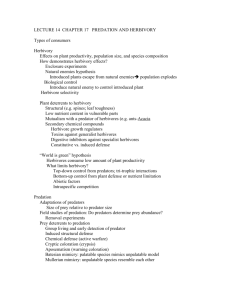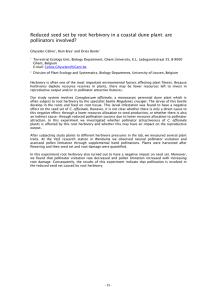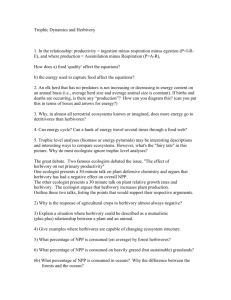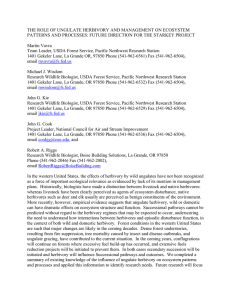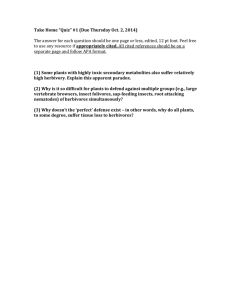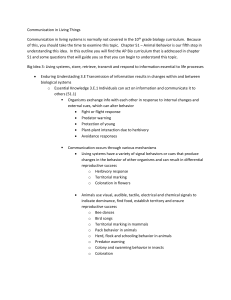Implications of Managing the Timing and Intensity of ... for Conservation of Arizona Leatherflower
advertisement
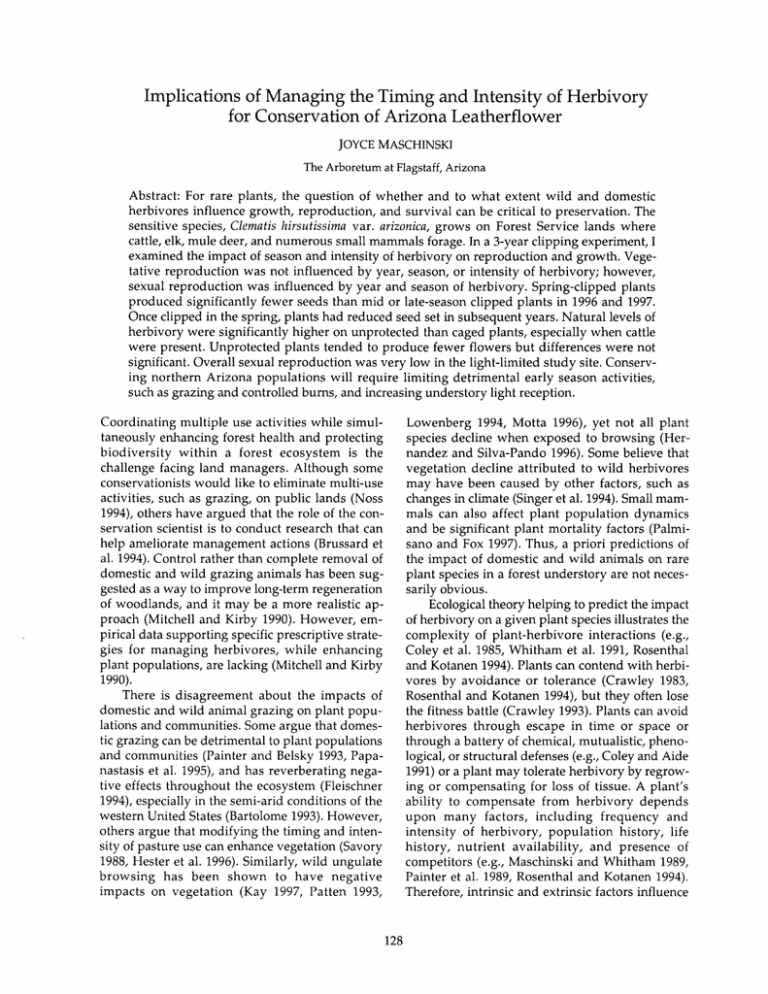
Implications of Managing the Timing and Intensity of Herbivory for Conservation of Arizona Leatherflower JOYCE MASCHINSKI The Arboretum at Flagstaff, Arizona Abstract: For rare plants, the question of whether and to what extent wild and domestic herbivores influence growth, reproduction, and survival can be critical to preservation. The sensitive species, Clematis hirsutissima var. arizonica, grows on Forest Service lands where cattle, elk, mule deer, and numerous small mammals forage. In a 3-year clipping experiment, I examined the impact of season and intensity of herbivory on reproduction and growth. Vegetative reproduction was not influenced by year, season, or intensity of herbivory; however, sexual reproduction was influenced by year and season of herbivory. Spring-clipped plants produced significantly fewer seeds than mid or late-season clipped plants in 1996 and 1997. Once clipped in the spring, plants had reduced seed set in subsequent years. Natural levels of herbivory were significantly higher on unprotected than caged plants, especially when cattle were present. Unprotected plants tended to produce fewer flowers but differences were not significant. Overall sexual reproduction was very low in the light-limited study site. Conserving northern Arizona populations will require limiting detrimental early season activities, such as grazing and controlled bums, and increasing understory light reception. Coordinating multiple use activities while simultaneously enhancing forest health and protecting biodiversity within a forest ecosystem is the challenge facing land managers. Although some conservationists would like to eliminate multi-use activities, such as grazing, on public lands (Noss 1994), others have argued that the role of the conservation scientist is to conduct research that can help ameliorate management actions (Brussard et al. 1994). Control rather than complete removal of domestic and wild grazing animals has been suggested as a way to improve long-term regeneration of woodlands, and it may be a more realistic approach (Mitchell and Kirby 1990). However, empirical data supporting specific prescriptive strategies for managing herbivores, while enhancing plant populations, are lacking (Mitchell and Kirby 1990). There is disagreement about the impacts of domestic and wild animal grazing on plant populations and communities. Some argue that domestic grazing can be detrimental to plant populations and communities (Painter and Belsky 1993, Papanastasis et al. 1995), and has reverberating negative effects throughout the ecosystem (Fleischner 1994), especially in the semi-arid conditions of the western United States (Bartolome 1993).However, others argue that modifying the timing and intensity of pasture use can enhance vegetation (Savory 1988, Hester et al. 1996). Similarly, wild ungulate browsing has been shown to have negative impacts on vegetation (Kay 1997, Patten 1993, Lowenberg 1994, Motta 1996), yet not all plant species decline when exposed to browsing (Hernandez and Silva-Pando 1996). Some believe that vegetation decline attributed to wild herbivores may have been caused by other factors, such as changes in climate (Singer et al. 1994).Small mammals can also affect plant population dynamics and be significant plant mortality factors (Palmisano and Fox 1997). Thus, a priori predictions of the impact of domestic and wild animals on rare plant species in a forest understory are not necessarily obvious. Ecological theory helping to predict the impact of herbivory on a given plant species illustrates the complexity of plant-herbivore interactions (e.g., Coley et al. 1985, Whitham et al. 1991, Rosenthal and Kotanen 1994). Plants can contend with herbivores by avoidance or tolerance (Crawley 1983, Rosenthal and Kotanen 1994), but they often lose the fitness battle (Crawley 1993). Plants can avoid herbivores through escape in time or space or through a battery of chemical, mutualistic, phenological, or structural defenses (e.g., Coley and Aide 1991) or a plant may tolerate herbivory by regrowing or compensating for loss of tissue. A plant's ability to compensate from herbivory depends upon many factors, including frequency and intensity of herbivory, population history, life history, nutrient availability, and presence of competitors (e.g., Maschinski and Whitham 1989, Painter et al. 1989, Rosenthal and Kotanen 1994). Therefore, intrinsic and extrinsic factors influence the impact of herbivores on plants, but even knowing many of these factors may not allow absolute predictions that grazing or browsing will be detrimental to a species. This study addressed whether herbivory by wild and domestic mammals influenced the reproduction and growth of the rare forest understory plant species, Clematis hirsutissima var. arizonica. Because woody perennials growing in resourcelimited environments are predicted to undercompensate from herbivory (Whitham et al. 1991), I predicted that herbivory would be detrimental to C. hirsutissima var. arizonica. Yet, it is possible that controlling the season of use and intensity of herbivory could modify impacts on the plant, as has been seen in other plant species (e.g., Turnipseed 1972, Smith and Bass 1972, Maschinski and Whitham 1989, Paige 1992). I specifically asked four questions related to the management of herbivores and the conservation of C. hirsutissima var. arizonica: (1) Does the intensity of herbivory influence its growth and reproduction? (2) Does the season of herbivory affect its growth, reproduction, and survival? (3) Is it being eaten by large or small mammals? (4) Is it capable of compensating from herbivory? Methods The regionally rare herbaceous understory species, Arizona leatherflower (C. hirsutissima var. arizonica), is a categorized as a Forest Service Sensitive species. The variety is known from high elevations (2300-2800 m) near Flagstaff and Tusayan, Arizona, the Chuska Mountains on the Navajo Nation in northern Arizona, and the Zuni Mountains in New Mexico. Populations in New Mexico are associated with oak woodlands; however, in northern Arizona, where the largest populations exist, the species grows preferentially on north-facing limestone outcroppings in ponderosa pine (Pinus ponderosa) forests. Recent taxonomic review of the genus has lumped this variety with the more widespread C. hirsutissima var. hirsutissima, which has a distribution that extends from Arizona to British Columbia (Pringle 1997). The U.S. Fish and Wildlife Service consequently removed the species from candidate 1 status, but the Coconino National Forest maintains the variety as a Species of Concern. The populations in northern Arizona are patchily distributed and rare understory components. Throughout this paper, I have used the name Clematis hirsu tissima var. arizonica to clarify that I am discussing the northern Arizona population. C. hirsutissima var. arizonica is a 10-50 cm tall herbaceous perennial that has pinnately compound leaves on stems arising from a woody caudex (Kearney and Peebles 1960). Individuals can produce 1-50 stems, though most of the individuals in northern Arizona produce fewer than 6 stems (Maschinski et al. 1997). Solitary purple, bell-shaped flowers on the ends of stems and lateral shoots bear 18-30 achenes with plumose styles 1-6 cm in length, but the quality of seeds is influenced by environment and outcrossing (Maschinski 1989). Most plants produce fewer than eight flowers that set seed (Maschinski et al. 1997). Although flowers can set some seed without outcrossing, preliminary tests indicate that selfed seed has reduced viability in comparison to outcrossed seed (Maschinski 1989).Germination of outcrossed seed after long periods of stratification under greenhouse and field conditions is less than 1 percent (Maschinski, unpublished data). Shoots elongate from a perennial caudex in early May, usually flower by the beginning of June, and set seed by August. In the fall, after seeds are shed, aboveground vegetation dies back. A major anthropogenic factor believed to threaten the species is herbivory. In pastures where C. hirsutissima var. arizonica grows on the Coconino National Forest, cattle herds graze on a rest-rotation grazing system. In addition, approximately 1500 elk (Cervus elaphus nelsonii) and less abundant numbers of mule deer (Odocoileus hemionus) utilize the area (Arizona Game and Fish Department 1993). Other potential mammalian herbivores in the vicinity are golden mantle ground squirrels (Spermophilus lateralis), pocket gophers (Thomomys bottae), voles (Microtus mexicanus), deer mice (Peromyscus maniculatus), and cottontails (Sylvilagus audubonii ssp. warreni). Observations made from 1989 to 1995 of natural levels of herbivory indicated that C. hirsutissima var. arizonica experienced two different degrees of mammalian herbivory: light herbivory, where only flowers were eaten, and heavy herbivory, where all but 4 cm of stems were eaten (Maschinski 1996). In 5 years of observation, there was no consistent spatial pattern of herbivore use on C. hirsutissima var. arizonica that suggested any preferential site or genotype that received heavy or light herbivory (Maschinski 1996, Maschinski et al. 1997). In Arizona, wild mammals are managed by the Arizona Game and Fish Department, whereas cattle are managed by permittees under U.S. Forest Service guidelines. Hence, the agency responsible for economic or management deci- sions linked to the preservation of C. hirsutissima var. arizonica may change depending upon the herbivore utilizing the plant. I conducted these studies in the vicinity of Lake Mary, 26 km southwest of Flagstaff, Arizona (2118 m elevation). The study area has cold winters and variable precipitation throughout the year (Figure 1). Yearly mean temperature is 7" C; freezing temperatures can occur any month of the year. Precipitation is minimal or absent in May and June; monsoon rains usually begin in July and last through September. From 1995 to 1997, the duration of this experiment, there was significant variation in annual precipitation (see Figure 1). Total annual precipitation was 66.3 cm, 46.25 cm, and 67.54 cm in 1995, 1996, and 1997, respectively. Between October 1995 and June 1996, less than 14 cm of precipitation fell, the lowest recorded in the past 100 years. Clipping Experiments To evaluate the impact of the timing and intensity of herbivory on C. hirsutissima var. arizonica, I selected 366 plants for the experiment in the spring of 1995. All plants were growing on limestone outcroppings. Canopy cover of experimental plants ranged from 22 to 39 percent of full sun and forest litter ranged from 10 to 15.5 cm in depth. I caged all plants with 1.6 m tall hog-wire and chicken-wire fencing that excluded large herbivores known to graze in the vicinity (elk, deer, and cattle), but did not exclude small mammals. Because there are only approximately 1500 individuals in the Flagstaff area, the plants used in this and the second experiment represented 27 percent of the existing plants. As a Forest Service sensitive species, actions that may have harmed the continued existence of the species were rigorously controlled. Because it was not known whether treatments would kill plants, the number of plants I was able to use in this study was restricted. To address whether the intensity of herbivory influenced C. hirsutissima var. arizonica growth and reproduction, I mimicked previously observed natural levels of herbivory with a clipping treatment. I assigned plants randomly to one of three clipping treatments: light herbivory where only the first centimeter below the flower bud was clipped, heavy herbivory where plants were clipped to 4 cm above the ground, or controls with no clipping treatment. To determine whether the season in which herbivory occurred influenced plant reproduction and growth, I assigned clipping treatment and control plants randomly to one of three seasons of herbivory: early season herbivory was simulated by clipping in May, mid-season herbivory was simulated by clipping in July, and late-season herbivory was simulated by clipping in September-October. Thus, plants were assigned to one of seven treatments: light clipping in May, heavy clipping in May, light clipping in July, heavy clipping in July, light clipping in September-October, heavy clipping in SeptemberOctober, and caged controls with no clipping treatment. Plants were clipped 22-27 May, 21-25 July, and 25 September-20 October of 1995; 10-23 May, 24-30 July, and 3-10 September of 1996; and 6-7 May, 1-3 July, and 2-4 Sept of 1997. I noted the number of successful and unsuccessful flowers or dried buds, the total number of stems, and the total stems eaten on all individuals. To assess potential compensation for clipping, I measured the numbers of lateral shoots produced by each stem and the reproductive condition of lateral shoots. In all figures the numbers of flowers and stems reflect the fall condition before the plant received the clipping treatment. I included only plants that survived for all 3 years of the experiment. During the course of this experiment, no cattle were present at the study site in 1995, 520 cows and calves were present in July of 1996 for 28 days, and 250 cows and calves were present for 31 days in August 1997. To compare the impact of timing and intensity of clipping across years, I analyzed vegetative reproduction and sexual reproduction for September-October 1995,1996, and 1997 using SYSTAT's General Linear Model repeated measures analysis of variance (SPSS 1996), which had two fixed main effects: season of clipping (early, mid, and late) and clipping intensity (low, high, and none); and the repeated measure was year (1995, 1996, and 1997). I log transformed reproductive measures to normalize the data. To account for multiple measures on experimental units, I used a Bonferroni adjustment for alpha levels (Snedecor and Cochran 1980). In addition, I assessed reproductive failure across years and groups by comparing the percent of dried buds on main stems and lateral shoots using the Kruskal-Wallis test (Zar 1984). Natural Levels of Herbivory To examine the impact of natural levels of herbivory, I compared vegetative reproduction, sexual reproduction, and the number of stems eaten of 35 unprotected plants and 69 caged con- SEP MAR AUG 1994 4 f AUG 1995 1996 1997 Figure 1. Annual precipitation from 1994 to 1997 in Flagstaff, Arizona. trols over the 3 years of the study. I measured the same plant characteristics as above and compared these data using a repeated measures analysis of variance, where caging was the fixed effect and year was the repeated measure. Within each year, I examined natural levels of herbivory across the seasons using analysis of variance. Results Clipping Experiment - Eflects of Season of Clipping The number of C. hirsutissima var. arizonica stems and lateral shoots produced did not vary significantly with season of clipping (Table 1). Although there was a tendency for early season clipped plants to produce more lateral shoots than late season plants, this difference was not significant (Figure 2). Season of clipping did significantly affect the number of C. hirsutissima var. arizonica flowers that set seed (see Table 1). In 1996 and 1997, late-season clipped plants produced 67-59 percent more flowers that set seed than early season clipped plants (Figure 3). As the growing season progressed, plants had more time to produce flowers; thus plants in the late-season clipped treatment groups had the greatest opportunity to produce flowers before the clipping treatment, regardless of the intensity of herbivory (see Figure 3). Early season clipping was the most detrimental to sexual reproduction in 2 of 3 years (see Figure 3). Clipping Experiment - Eflects of Clipping l n tensity Neither vegetative nor sexual reproduction varied significantly across intensities of clipping treatments (see Table 1). There was no significant effect of clipping on plant survival regardless of intensity. Clipping Experilnent - Eflects of Year The number of stems and lateral shoots produced did not vary significantly in any year (see Table 1). Despite climatic variation, both lateral and main stem production were relatively stable across years (Figure 4). Table 1. Repeated measures analysis of variance for total number of stems and lateral shoots, and total flowers on main and lateral stems that set seed in three seasons (early, mid, and late), for three intensities of clipping (low, high, and none), measured in September 1995,1996, and 1997. Total number of stems and lateral shoots Total flowers that set seed on main and lateral stems .......*......-..*..-..-..-.--...-.-..---.-.....*........... Source df MS F D Season Intensity SxI Error Year YxS YxI YxSxI Error II Laterals Main Stems Early Mid Late Figure 2. Vegetative reproduction of Clematis hirsutissima var. arizonica in early, mid, and late clipping groups averaged over 1995,1996, and 1997. Early groups received clipping treatment in May, mid groups received clipping treatrnent in July, and late groups received clipping in September-October. Means f 1 SE are indicated. Figure 3. Sexual reproduction of Clematis hirsutissima var. arizonica in early, mid, and late clipping groups in 1995, 1996, and 1997. Early groups received clipping treatment in May, mid groups received clipping treatment in July, and late groups received clipping in September-October. Means 1SE are indicated. + Lateral Shoots EZ Main Si:ems Figure 4. Vegetative reproduction of Clematis hirsutissima var. arizonica in 1995,1996, and 1997. Means f 1 SE are indicated. In contrast, sexual reproduction was significantly affected by year. The greatest total flower production occurred in 1997 (Table 1, Figure 5). In most clipping intensity/season groups, total flower production increased in 1997; however, the exceptions are noteworthy (Figure 6). Both the low and high intensity, early season clipped plants produced fewer flowers that set seed in 1997 compared to 1995 or 1996. This indicates a long-term negative impact from early season herbivory on reproduction. Plants in the early season treatment did not recover as the other treatment groups did even in the comparatively wet year of 1997. The only way that C. hirsutissima var. arizonica stems could compensate for loss of flowers or portions of stems after the clipping treatment was through production of lateral shoots, which in turn produced flowers. The contribution to flower production from lateral shoots varied with year (Year F2,714 = 4.86, p < 0.001, see Figure 5). For most groups, lateral shoot contribution to reproduction was greatest in 1997 (see Figure 6). However, there was no significant effect of season or intensity on the number of lateral flowers that successfully set seed (Season F2,357 = 0.172, p > 0.05; Intensity F2,357= 0.517, p > 0.05). Although C. hirsutissima var. arizonica attempted to compensate for the loss of flowers by producing lateral shoots, no group completely replaced or compensated for flowers lost to clipping. on caged controls, as large mammals were excluded. The greatest herbivory on caged plants occurred in 1996. The timing of natural herbivory within each year increased as the season progressed (1995 FlIlo2 = 14.29, p < 0.001; 1996 F1,iO2= 22.45, p < 0.001; 1997 FlIlo2 = 40.47, p < 0.001). The greatest amount of herbivory occurred late in the season in all years with little or no herbivory occurring in the spring (see Figure 7). The exception to this pattern was in 1996, the driest year, when both caged and unprotected plants experienced herbivory in the spring. In 1996 and 1997, when cattle were present at the site, uncaged plants experienced significantly higher levels of herbivory than in seasons or years when cattle were not present. Because cattle were not present in 1995, wild animals account for herbivory that year. Similarly, wild animals accounted for spring 1996 herbivory, because cattle were not present on the study site until mid-season. Protecting plants from large herbivores with caging did not significantly influence stem, lateral shoot, or seed production, despite the fact that uncaged plants had greater levels of herbivory (Table 2). For all characters, there was a trend for higher production with caging, however none of these comparisons was significant (Stem F1,lO2= 0.6, p > 0.05; Lateral FlIlo2 = 0. 4, p > 0.05; Seed FlIlo2= 0.58, p > 0.05). Experiment 2 - Natural Levels of Herbivory Discussion In comparison to caged controls, unprotected plants that were exposed to both small and large herbivores experienced significantly more herbivory (F1,lO2= 22.83, p < 0.01, Figure 7). In 1995, 1996, and 1997, unprotected controls experienced 40,55, and 92 percent more herbivory than caged plants. Small mammals account for all herbivory Regardless of climatic variation across years, or the timing or intensity of herbivory, vegetative reproduction of C. hirsutissima var. arizonica was stable, whereas seed production was very sensitive to season of herbivory and climate. Clipping treatments may have removed biomass, but this did not influence total stem production in subsequent Table 2. Comparison of the number of flowers setting seed, stems, and lateral shoots of caged versus uncaged Clematis hirsutissima var. arizonica. Neither year or caging significantly influenced any character. Character Year Caged Uncaged No. of flowers setting seed 1995 1996 1997 0.44 f 0.15 0.39 0.10 0.71 0.20 0.49 f 0.21 0.23 f 0.14 0.40 f 0.28 Stems 1995 1996 1997 + + 2.65 + 0.25 2.67 + 0.24 2.28 + 0.20 Lateral shoots 1995 1996 1997 1.30 f 0.25 1.39 f 0.41 1.09 0.25 0.57 f 0.34 1.74 f 0.41 0.94 f 0.36 + 2.49 f 0.34 2.06 f 0.34 2.37 f 0.28 Lateral Shoots Main Stems Figure 5. Mean number of flowers setting seed on main and lateral stems of Clematis hirsutissima var. arizonica in 1995,1996 and 1997. Means f 1SE are indicated. years. Neither low nor high intensities of clipping induced consistent, substantial lateral shoot growth. Conversely, sexual reproduction was influenced by climatic variation and the timing of herbivory. Early-season herbivory reduced seed set within the year of treatment and in subsequent years, whereas late-season herbivory had little effect on sexual reproduction within or across years. This finding contrasts to previous studies on other herbaceous species indicating early season herbivory was less detrimental because plants had more time to recover within a single growing season (i.e., Maschinski and Whitham 1989). Apparently early-season herbivory on C . hirsutissima var. arizonica depletes a carbohydrate reserve that is not replaced within the season and compensatory flower production cannot occur. The second experiment comparing caged versus unprotected controls demonstrated that both small and large mammals feed upon C. hirsutissima var. arizonica. The number of stems eaten was always significantly higher on uncaged versus caged plants, indicating that large mammals were responsible for most herbivory on natural populations of Clematis. The highest levels of herbivory occurred when cattle were present on the pasture (in July 1996 and August 1997) and when precipitation was low. The greatest amount of spring herbivory inside and outside cages occurred following the prolonged drought in 1996 when less understory vegetation was available for all herbivores. Although caged plants experienced significantly less herbivory, this did not result in significantly greater seed production (see Table 2). The overall low reproduction of plants can explain this finding. Many stems and lateral shoots did not produce successful flowers regardless of whether they were browsed or not. The general reproductive success of the species is problematic and is probably related to both climate and overall forest health. Sexual reproduction was extremely low overall, such that the mean number of flowers setting seed per individual was < 1 in most groups in 1995 and 1996. In 1997, the mean number of flowers setting seed increased to >1 in most groups except early season. Arid con- Lateral Shoots H Main 95 97 95 97 95 97 95 97 95 97 95 97 95 97 L H L H L H Control EARLY MID LATE Figure 6. Mean number of Clematis hirsufissima var. arizonica flowers that set seed on main and lateral shoots for treatment groups. Measurements taken in September 1995, 1996, and 1997 are reported in adjacent columns for each treahnent group. L and H signify light and heavy clipping treatments. Control group received no clipping treatment. Early groups received clipping treatment in May, mid groups received clipping treatment in July, and late groups received clipping in September-October.Means k 1 SE are indicated. ditions coupled with unpredictable freezes may contribute to high percentages of flower and bud death, as is seen with many blooming plants in the region. In addition, previous studies have shown that the reproductive success of C. hirsutissima var. arizonica is significantly greater in canopies with approximately 50 percent light (Maschinski et al. 1997). At light levels greater than 75 percent, plants suffer from high bud mortality, low seed viability, low seedling establishment, low midseason water potentials, and high exposure to competing grasses. At light levels less than 40 percent plants had low seed and stem production and low photosynthetic rates (Maschinski et al. 1997). Because the mean light levels received by plants in this study were 22-39 percent light, plants were light-limited. The reason for the lightlimitation is probably related to disrupted patterns of fire frequency in Pinus ponderosa forests of this region. Fire suppression, which began as early as 1908 in the Flagstaff area, has had ecosystem-level effects resulting in overstocked patches of saplings and pole-sized trees, greater canopy closure, reduced tree growth, stagnated nutrient cycles, and decreased on-site water balance (Covington and Moore 1994). The low productivity of the study site contributed to the low reproductive success of the species and to the relatively lower influence of Early Med EZI Late CAGE NO 1995 CAGE NO 1996 I CAGE NO 1997 Figure 7. Comparison of the mean number of Clematis hirsutissima var. arizonica stems eaten by mammals in early, mid and late season in 1995,1996 and 1997 on caged and unprotected plants. herbivores on sexual reproduction, as has been seen in other systems (John and Turkington 1995). The results of this study have management implications for the conservation of C. hirsutissima var. arizonica. Early-season cattle grazing in C. hirsutissima var. arizonica pastures would be very detrimental to this species. Therefore it would be advisable to limit cattle use of pastures where C . hirsutissima var. arizonica grows to the late summer and fall after plants have shed seed. It is likely that other management activities, such as controlled burns, would also be detrimental to C. hirsutissima var. arizonica early in the season. Because the reproductive success of the species is so limited, any management activity that enhanced wild or domestic herbivores would be inadvisable. These management suggestions can be considered as one piece in the overall puzzle of managing the diversity of the entire forest. Acknowledgments Thanks to Joanne Baggs, Mary Beach, Cheryl Casey, Stephanie Galgon, Karen Hueston, Kenric Kesler, Kai and Mira Petersen, Jeff Peterson, Ron Popowski, Nigel Sparks, Beth Williams, and A1 Zalfini for field assistance. Barbara Phillips and Heather Green of the U.S. Forest Service provided logistical support for these studies. This study was funded by Section 6 cost-share contracts from the Arizona Department of Agriculture through the efforts of Bruce Palmer, Angie Brooks, and Jim McGinnis. Literature Cited Arizona Game and Fish De artment. 1993. Arizona elk management operationa plan. Phoenix. Bartolome, J. W. 1993. Application of herbivore o timization theory to rangelands of the western 8nited States. Ecological A plications 3:27-29. Brussard, P. F., D. D. R u r h , and C. R. Tracy. 1994. Cattle and conservation giolbgy-another view. Conservation Biolo 8:919-921. Coley, P. D., and P M . Aide. 1991. Comparison of herbivor and plant defenses in temperate and tropical b roa leaved forests. In P. W. Price, T. W. Lewinsohn, W. W. Benson, and G. W. Fernandez, eds. Plant-animal interactions: Evolutionar ecolo y in tropical and temperate regions, pp. 23-50. 8 d e y , New York. Coley, P. D., J. P. Bryant, and F. S. Chapin, 111. 1985. Resource availabilit and plant antiherbivory defense. Science 230:895-859. Covington, W. W., and M. M. Moore. 1994. Southwestern onderosa forest structure. Journal of Forestry 923:4 !7. Crawley, M. J. 1983. Herbivory: The d namics of animal-plant interactions. University of alifornia Press, Berkeley. Crawle ,M. J. 1993. On the consequences of herbivory. EvoLtionary Ecolo y 7:124-125. Fleischner, T. L. 1994. &cological costs of livestock grazin in western North America. Conservation Biology 8:f29444. Hernandez, M. P. G., and F. J. Silva-Pando. 1996. Grazing; effects of ungulates in a Galician oak forest (ngrthwest spainF Forest Ecology and Mangement 88:6!%70. ---Hester, A. J., F. J. G. Mitchell, and K. J. Kirby. 1996. Effects of season and intensity of shee grazing on tree re eneration in a British u lan woodland. Forest 8colog and Management 8[:99-106. John, E., and R. $urkington. 1995. Herbaceous ve etation in the understory of the boreal forest: boes nutrient supply or snowshoe hare herbivory re ulate species com osition and abundance? Journal ofEcology 83:581-l90. Kay, C. E. 1997. Viewpoint: Ungulate herbivory, willows, and political ecology in Yellowstone. Journal of Range Mana ement 50:139-145. Kearney, T., a n f ~H. . Peebles. 1960. Arizona flora. University of California Press, Berkeley. Lowenberg, G. J. 1994. Effects of floral herbivor on maternal reproduction in Sanicula arctopides (lpiaceae). Ecology 75:359-369. Maschinski, J. 1989. Factors~limitingreproductive success of Arizona leatherflower rowin in Lake Mary timber sale area. Report 43-8153-9-3055 to Coconino National Forest, Fla staff, Arizona. 21 pp. Maschinski, J. 1996. Effects of shading on sexual and asexual reproduction and population dynamics of Clematis hzrsutissima var. arizonica. Report to Coconino National Forest, Flagstaff, Arizona. 15 p. Maschinski, J., T. E. Kolb, E. Smith, and B. PhilEps. 1997. Potential im acts of timber harvesting on a rare understory prant, Clematis hirsutissima var. arizonica. Biological Conservation 80:49-61. Maschinski, J., and T. G. Whitham. 1989. The continuum of plant responses to herbivor : The influence of plant association, nutrient avaiibility, and timing. American Naturalist 134:1-19. P B 6 $ Mitchell, F. J. G., and K. J. Kirby. 1990. The im act of large herbivores and the conservation oPseminatural woods in the British uplands. Forestry 63:333-353. Motta, R. 1996. Impact of wild ungulates on forest regeneration and tree composition of mountain forests in the western Italian Alps. Forest Ecology and Mana ement 88:93-98. Noss, R. F. 1894. Cows and conservation biology. Conservation Biology 8:613416. Paige, K. N. 1992. Overcompensation in response to mammalian herbivory: From mutualistic to antagonistic interactions. Ecolog 73:2076-2085. ~ . Ap lication of Painter, E. L., and A. J. ~ e r s k 1993. herbivore optimization theory to ran egnds of the ons western United States. Ecolo ical ~ ~ ~ f c a t i3:2-9. Painter, E. L., J. K. Detlin and %. A. Steingraeber. 1989. Grazing history, def8iation, and frequency-dependent competition: Effects on two North American grasses. American Journal of Botan 76:1368-1379. Palmisano, S., and L. R. Fox. 1997. EGects of mammal and insect herbivory on population dynamics of a native Californian thistle, Cirsium occidentale. Oecologia 111:413421. Papanastasis, V., Z. Koukoura, D. Alifragis, and I. Makedos. 1995. Effects of thinning, fertilisation, and sheep grazing on the understory vegetation of Pinus pinaster plantations. Forest Ecology and Management 77:181-189. Patten, D. T. 1993. Herbivore o timization and overcompensation: Does native Rerbivory on western rangelands su port these theories? Ecological Applications 335-3! Pringle, J. S. 1997. Clematis. In Flora of North America, vol. 3, pp. 160-176. Oxford University Press, New York. Rosenthal, J. P., and P. M. Kotanen. 1994. Terrestrial lant tolerance to herbivory. Trends in Ecology & ffvolution 9:145-148. Savory, A. 1988. Holistic resource mangement. Island Press, Washington, D.C. Sin er, F. J., L. C. Mark, and R. C. Cates. 1994. Ungulate kerbivory of willows on Yellowstone's northern winter range. Journal of Range Management 47:435443. Smith, R. H., and M. H. Bass. 1972. Relation of artificial od removal to so bean yields. Journal of Economic Entornolog 65:60&508 Snedecor, G. and W. k. Cochran. 1980. Statistical methods. Iowa State University Press, Ames. SPSS Inc. 1996. SYSTAT 6.0 for Windows: Statistics. Chicago, Illinois. Turnipseed, S. G. 1972. Response of so beans to foliage losses in South Carolina. Journal o Economic Entomology 65:224-229. Whitham, T. G., J. Maschinski, K. C. Larson, and K. N. Paige. 1991. Plant responses to herbivory: The continuum from negative to positive and underlyin hysiological mechanisms. In P. W. Price, T. Eewinsohn, W. W. Benson, and G. W. Fernandez, eds. Plant-animal interactions: Evolutionary ecolo in tropical and temperate regions, pp. 227-2$; Wile New York. Zar, J. I? 1984. Biostatistical analysis. 2nd ed. Prentice Hall, Englewood Cliffs, New Jersey. &., Y 2
